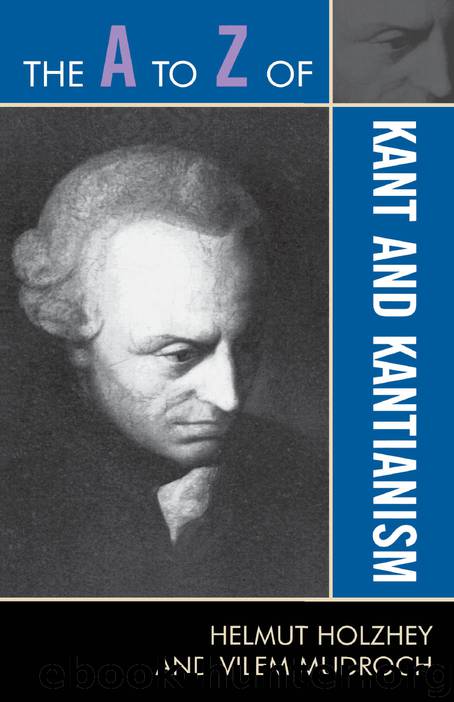The A to Z of Kant and Kantianism by Helmut Holzhey & Vilem Mudroch

Author:Helmut Holzhey & Vilem Mudroch
Language: eng
Format: epub
Publisher: Scarecrow Press
Published: 2005-04-15T04:00:00+00:00
- M -
MAGNITUDE (Grösse). Magnitude is a property of all appearances, since all appearances stand under the categorical synthesis, and the mathematical categories, both quantity and quality, have to do with magnitude. In addition, magnitude is the concept under which the understanding subsumes all intuitions in space and time, thus making the application of mathematics to experience possible. Kant distinguished between extensive magnitudes, discussed in the “Axioms of Intuition,” and intensive magnitudes, dealt with in the “Anticipations of Perception.” The former arise on the basis of the categories of quantity, the latter on the basis of quality. However, outside of the context of these two mathematical principles of the understanding, Kant generally referred with the term ‘magnitude’ only to extensive magnitude, defining it at one point as “a determination of how many times a unit is posited in a thing,” claiming that this “how-many-times is grounded on successive repetition, thus on time and the synthesis (of the homogeneous) in it” (A 242/B 300).
As Kant considered both extensive and intensive magnitudes to be continuous, he claimed that all appearances were continuous (A 170/B 212). In the case of extensive magnitudes, their continuity was based on the fact that space and time are continuous, that is, that between any two points in space or time there are again spatial or temporal parts, the points being mere boundaries. For intensive magnitudes, the reality, that is, degree of a perception could be diminished by infinitesimally small steps until it would reach zero, at which point, reality would no longer be reality, but negation. The discipline that dealt with magnitudes first and foremost was, for Kant, unsurprisingly, mathematics. Here, he thought that magnitudes could be constructed not only in arithmetic and geometry but also in algebra, namely, by means of a symbolic construction (A 717/B 745).
Kant takes up the concept of magnitude again in the Critique of Judgment, in the course of his discussion of the sublime, which he defines as something “absolutely large” or as “that in comparison with which everything else is small” (§ 25). This definition compels Kant to consider what magnitude in aesthetic terms means. In this connection, he distinguishes between the mathematical determination of size by means of numbers or signs (as in algebra), and the nonmathematical estimate of the magnitude of all objects of nature, an estimate he considers to be aesthetic. Such an estimate is expressed by reflective judgments, and it is in this fashion that we judge whether something is sublime or not (§ 26).
MAIMON, SALOMON (1753–1800). While Friedrich Heinrich Jacobi and Gottlob Ernst Schulze leaned in their examination of Kant’s criticism on the philosophy of David Hume, Maimon took in his own interpretation and further development of the critical philosophy far more strongly elements of the Leibniz-Wolff school into consideration. Maimon criticized as illusory the common notion of the things-in-themselves that affect us, assigning to things-in-themselves, nevertheless, a positive signification: he identified cognition of them with the completeness of the cognition of appearances. According to Maimon,
Download
This site does not store any files on its server. We only index and link to content provided by other sites. Please contact the content providers to delete copyright contents if any and email us, we'll remove relevant links or contents immediately.
A Dictionary of Sociology by Unknown(3031)
The Art of Dramatic Writing: Its Basis in the Creative Interpretation of Human Motives by Egri Lajos(3017)
The Dictionary of Body Language by Joe Navarro(2947)
0041152001443424520 .pdf by Unknown(2785)
How The Mind Works by Steven Pinker(2732)
Day by Elie Wiesel(2721)
Merriam-Webster's Collegiate Thesaurus, Second Edition by Merriam-Webster Inc(2711)
The Meaning of the Library by unknow(2508)
The Official Guide to the TOEFL Test by ETS(2288)
A History of Warfare by John Keegan(2186)
The Emotion Thesaurus: A Writer's Guide to Character Expression by Puglisi Becca & Ackerman Angela(2124)
Emotion Amplifiers by Angela Ackerman & Becca Puglisi(2009)
MASTER LISTS FOR WRITERS: Thesauruses, Plots, Character Traits, Names, and More by Bryn Donovan(1911)
The Cambridge Guide to English Usage by PAM PETERS(1882)
Merriam-Webster's Pocket Dictionary by Merriam-Webster(1882)
Star Wars The Rise of Skywalker The Visual Dictionary by Pablo Hidalgo(1846)
Lucky Jim by Kingsley Amis(1707)
American Accent Training by Ann Cook(1637)
Word by Word by Kory Stamper(1616)
